“Half a league from this city is a temple called Angar. It is of such extraordinary construction that it is not possible to describe it with a pen, particularly since it is like no other building in the world. It has towers and decoration and all the refinements which the human genius can conceive of. There are many smaller towers of similar style, in the same stone, which are gilded. The temple is surrounded by a moat, and access is by a single bridge, protected by two stone tigers so grand and fearsome as to strike terror into the visitor.”
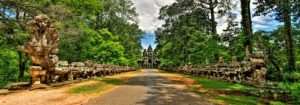 Long before the Portuguese historian Diogo Do Couto drew these conclusions from the marvelling sights before him in 1586, the imperious temple of Angkor Wat had already been transformed from a Hindu temple to one representing Buddhism. A transition that set the symbolism of its religious affiliation to this day. Much of the commissioning behind the construction of Angkor Wat is enshrined in myth and legend. One of the many stories told about its origins regards the temple to have been built as a directive from Hindu god Indra, known as the King of the Devas (Devas being benevolent supernatural beings). Others, such as the thirteenth century Chinese diplomat Zhou Daguan, assured that the entire structure had been erected overnight by what he claims was a divine architect.
Long before the Portuguese historian Diogo Do Couto drew these conclusions from the marvelling sights before him in 1586, the imperious temple of Angkor Wat had already been transformed from a Hindu temple to one representing Buddhism. A transition that set the symbolism of its religious affiliation to this day. Much of the commissioning behind the construction of Angkor Wat is enshrined in myth and legend. One of the many stories told about its origins regards the temple to have been built as a directive from Hindu god Indra, known as the King of the Devas (Devas being benevolent supernatural beings). Others, such as the thirteenth century Chinese diplomat Zhou Daguan, assured that the entire structure had been erected overnight by what he claims was a divine architect.
 The “City of Temples” as its Sanskrit etymology translates to, was dedicated to Hindu god Vishnu the Protector, and was built during the reign of the Khmer King Suryavarman II. The monarch would never see the finished product of such symbolic construction. Symbolic, for this was not only the largest religious monument in the world; it was to be, though unknown to him at the time, the largest religious monument to have ever been created to this date. Neither would it have been known to him that upon his death (almost a century and a half later) a series of internal and foreign religious power struggles would culminate in Buddhism emerging as the state religion of the Khmer Empire under his grandchild Indrawarman III. This thus settled the turning point of a quest to claim power of the greatest shrine in South East Asia. Such covet led to it never being deserted at any point of its history, remaining in continuous usage since its creation unlike other temples. Its curious westward orientation was a topic of mystery during early years, for the west is set to symbolise the direction of death, convincing many that Angkor Wat was a tomb. Much debate led to the common current consensus that the site may have served simultaneously as a temple and as a mausoleum for its creator, Suryavarman II.
The “City of Temples” as its Sanskrit etymology translates to, was dedicated to Hindu god Vishnu the Protector, and was built during the reign of the Khmer King Suryavarman II. The monarch would never see the finished product of such symbolic construction. Symbolic, for this was not only the largest religious monument in the world; it was to be, though unknown to him at the time, the largest religious monument to have ever been created to this date. Neither would it have been known to him that upon his death (almost a century and a half later) a series of internal and foreign religious power struggles would culminate in Buddhism emerging as the state religion of the Khmer Empire under his grandchild Indrawarman III. This thus settled the turning point of a quest to claim power of the greatest shrine in South East Asia. Such covet led to it never being deserted at any point of its history, remaining in continuous usage since its creation unlike other temples. Its curious westward orientation was a topic of mystery during early years, for the west is set to symbolise the direction of death, convincing many that Angkor Wat was a tomb. Much debate led to the common current consensus that the site may have served simultaneously as a temple and as a mausoleum for its creator, Suryavarman II.
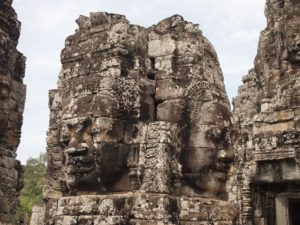 But as much as it was a blessing, Angkor Wat led equally to the interest of colonialism, particularly from the French, who saw the appeal in its potential as one of the primary factors to make Cambodia part of their network of protectorates. Great cultural benefit was obtained from it back in Europe, through exhibitions and proud showcasing of its great historical value. Displays, museums and fairs were wholly dedicated to the marvel, which catapulted its fame in the old continent. The temple overcame several obstacles since the end of the French protectorate, such as the reign of the Khmer Rouge which left the site to decay due to theft and civil war damage, and bombings from the United States that struck a pavilion. The former’s confrontation with Vietnam equally caused certain damage to some of the parts, but at large, the nine century-old temple has against all odds, retained its structural integrity.
But as much as it was a blessing, Angkor Wat led equally to the interest of colonialism, particularly from the French, who saw the appeal in its potential as one of the primary factors to make Cambodia part of their network of protectorates. Great cultural benefit was obtained from it back in Europe, through exhibitions and proud showcasing of its great historical value. Displays, museums and fairs were wholly dedicated to the marvel, which catapulted its fame in the old continent. The temple overcame several obstacles since the end of the French protectorate, such as the reign of the Khmer Rouge which left the site to decay due to theft and civil war damage, and bombings from the United States that struck a pavilion. The former’s confrontation with Vietnam equally caused certain damage to some of the parts, but at large, the nine century-old temple has against all odds, retained its structural integrity.
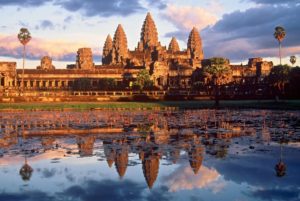 The sanctuary, has one of its instant appeals in the symmetrical approach to its architecture, which provides it with a sharp and attractive image. Surrounded by a perfectly square moat, Angkor Wat was mostly unaffected by changes in the advances of vegetation due to this stretch of water that separates the main section on which it is situated, from the outer forest area. Appealing too, is the central quincunx, which towers famously over the skyline. Made of sandstone, the usage of which had been mastered by architects of the twelfth century, it is rich in detail and carvings from an array of different periods can be seen enshrined across its walls. The bas-reliefs tell a story meant to be viewed counter-clockwise, something contributing to the ancient hypothesis that it was a burial site, given the Brahminic tradition leading to celebrate funerary processions in such order. It is of little wonder, given all these factors, that Angkor Wat was placed under the UNESCO Heritage site category in 1992.
The sanctuary, has one of its instant appeals in the symmetrical approach to its architecture, which provides it with a sharp and attractive image. Surrounded by a perfectly square moat, Angkor Wat was mostly unaffected by changes in the advances of vegetation due to this stretch of water that separates the main section on which it is situated, from the outer forest area. Appealing too, is the central quincunx, which towers famously over the skyline. Made of sandstone, the usage of which had been mastered by architects of the twelfth century, it is rich in detail and carvings from an array of different periods can be seen enshrined across its walls. The bas-reliefs tell a story meant to be viewed counter-clockwise, something contributing to the ancient hypothesis that it was a burial site, given the Brahminic tradition leading to celebrate funerary processions in such order. It is of little wonder, given all these factors, that Angkor Wat was placed under the UNESCO Heritage site category in 1992.
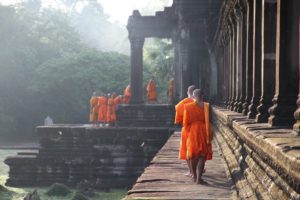 Angkor Wat is thus, as one would expect due to both its symbolism and its history, one of the most visited sites in the region. Numbers were as few as slightly over seven thousand people twenty years back. The appeal that Southeast Asia generated provided it with a sharp increase of visitors over the years, which today stands at almost three and a half million annual tourists. The increase in the infrastructural efficiency has been a large contributor to this too. As roads of greater capacity opened, the route became more appealing to all those wishing to visit the temple with ease. One of the most appealing road networks for instance, is that which connects all the way out to Thailand, through which access to Cambodia and the ancient site is very convenient. But if your thought is to travel by air, in a more comfortable and even smoother journey, one can travel to Siem Reap International Airport. Cambodia’s busiest airdrome is fantastically connected to an array of destinations throughout the entire region, with flights coming in from as far as Japan. The conveniently placed airport is only five and a half kilometres away from the site, making it a comfortable ten minute drive away.
Angkor Wat is thus, as one would expect due to both its symbolism and its history, one of the most visited sites in the region. Numbers were as few as slightly over seven thousand people twenty years back. The appeal that Southeast Asia generated provided it with a sharp increase of visitors over the years, which today stands at almost three and a half million annual tourists. The increase in the infrastructural efficiency has been a large contributor to this too. As roads of greater capacity opened, the route became more appealing to all those wishing to visit the temple with ease. One of the most appealing road networks for instance, is that which connects all the way out to Thailand, through which access to Cambodia and the ancient site is very convenient. But if your thought is to travel by air, in a more comfortable and even smoother journey, one can travel to Siem Reap International Airport. Cambodia’s busiest airdrome is fantastically connected to an array of destinations throughout the entire region, with flights coming in from as far as Japan. The conveniently placed airport is only five and a half kilometres away from the site, making it a comfortable ten minute drive away.
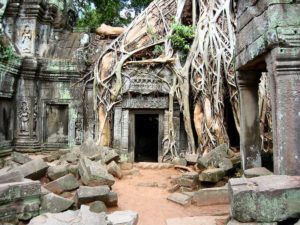 Tourism has equally brought a rather large quantity of revenue, much of which is used in order to remodel and maintain the Wat, as well as to keep the site clean. Most of the conservation though, is done by government sponsored specialist organisations, rather than by the local authorities. The success of Angkor Wat’s commercialisation was not without hard work however. Extensive restoration processes to keep it from decaying have been common. An appeal made by former Cambodian King Norodom Sihanouk placed it on the UNESCO World Heritage in Danger list, attracting the attention of organisations who took the challenge of refurbishing it. Previously, the task had been carried forth by the Archaeological Survey of India, who passed it onto the French once the latter came to recognise the reigning Cambodian government of the time. The move was to be positive, as the Indian effort had at times come under scrutiny due to the effect that the chemicals they used had on the stone. Today however, it is the representation of a well-managed conservation project, as its maintenance is efficient and careful.
Tourism has equally brought a rather large quantity of revenue, much of which is used in order to remodel and maintain the Wat, as well as to keep the site clean. Most of the conservation though, is done by government sponsored specialist organisations, rather than by the local authorities. The success of Angkor Wat’s commercialisation was not without hard work however. Extensive restoration processes to keep it from decaying have been common. An appeal made by former Cambodian King Norodom Sihanouk placed it on the UNESCO World Heritage in Danger list, attracting the attention of organisations who took the challenge of refurbishing it. Previously, the task had been carried forth by the Archaeological Survey of India, who passed it onto the French once the latter came to recognise the reigning Cambodian government of the time. The move was to be positive, as the Indian effort had at times come under scrutiny due to the effect that the chemicals they used had on the stone. Today however, it is the representation of a well-managed conservation project, as its maintenance is efficient and careful.
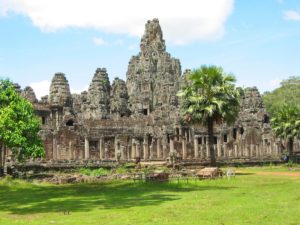 Angkor Wat is a monument of marvel: made of history, memories, religion, mythology and a large proportion of immaculately polished sandstone, it represents everything Cambodia has gone through as a nation and through everything its stands for. Majestically centred on the national flag is the frontal view of its towering quincunx, carrying the pride and joy of the country’s allegory. We recommend that you visit Angkor Wat if you have not yet done so, but remember to be a productive tourist, adhering to ways that will preserve its beauty and legacy. After all, as Henri Mouhot once said:
Angkor Wat is a monument of marvel: made of history, memories, religion, mythology and a large proportion of immaculately polished sandstone, it represents everything Cambodia has gone through as a nation and through everything its stands for. Majestically centred on the national flag is the frontal view of its towering quincunx, carrying the pride and joy of the country’s allegory. We recommend that you visit Angkor Wat if you have not yet done so, but remember to be a productive tourist, adhering to ways that will preserve its beauty and legacy. After all, as Henri Mouhot once said:
“To Khmer People, Angkor Wat is more than just an ancient pile of stones, it is more than just the remains of a highly advanced kingdom, it is more than just a tourist attraction – to the Khmers it is a symbol of hope.”


